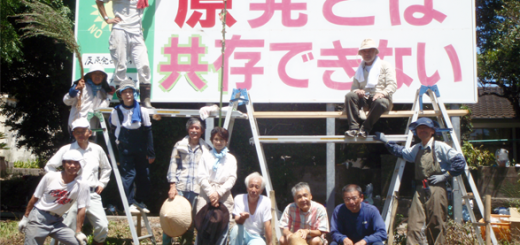Who’s Who: Kamata Satoshi
The Long-cherished Friendship between Kamata Satoshi and Takagi Jinzaburo through the Fight against the Nuclear Fuel Cycle
It was about 1977 that I met Kamata Satoshi for the first time. Along with my partner, the late Takagi Jinzaburō (former Director of Citizens’ Nuclear Information Center), I participated in the rally against the construction of Narita Airport. Organized by the Sanrizuka Opposition League against Construction of Narita International Airport, the rally took place in Sanrizuka, Narita, where the airport was under construction. Mr. Kamata was then executive secretary to the Association of the Declaration Demanding the Cancellation of the Sanrizuka Airport.* He and my partner were already acquainted with each other. Having published Jidōsha Zetsubō Kōjō (“Desperate Automotive Plants,” Gendaishi Shuppankai, Tokyo, 1973), Mr. Kamata was already prominent as a report writer specializing in social issues. I remember that the description of his own experience as a seasonal worker in the Toyota headquarters plant was reminiscent of the film Modern Times by Charlie Chaplin.
Takagi learned a lot from Mr. Kamata, who began his research in the Shimokita Peninsula, Aomori Prefecture, at the end of the 1960s, before the nuclear development project there became known. In the first publication from CNIC, Kakunenryō Saishori Kōjō — Sono Kikensei no Subete (“All the Dangers of the Nuclear Fuel Reprocessing Plant”) in 1977, Takagi inspected Tōkai Reprocessing Plant in Ibaraki Prefecture. At that time the Rokkasho nuclear fuel cycle project was still below the surface.
In the afterword of his book Nihon no Gempatsu Chitai (“Nuclear Power Plant Areas in Japan”) (first released from Ushio Publishing in 1982 and later paperbacked by Kawade Shobo Shinsha Publishers in 1988), Mr. Kamata wrote: “I traveled around the areas where nuclear power plants were built, trying to learn what led people into accepting the plants, what happened in the process of the acceptance, what thoughts the people have today, and how they are going to live. The conclusion I reached after the research was that those plants would never be compatible with democracy.” The paperback version includes Takagi’s commentary, “View from the forefront of incompatibility,” at the end of the book, in which he states: “Mr. Kamata’s appearance and narrative, which imply his stubbornness, somehow seems credible to me. His discerning vision, probably based on the acute intuition of commonfolk, always impresses me. In this respect I always read his reports with a clean conscience. What enables me to have such a frame of mind might be that his perspective is always on the same level as that of the people who intend to live in the area, deeply rooted in the local soil.”
In 1991, Mr. Kamata released Rokkasho Mura no Kiroku (“Records of Rokkasho Village,” Iwanami Shoten Publishers). The introduction on the wraparound band of the book reads: “The deserted village, built on reclaimed ground, now hosts the nuclear fuel disposal site — a 100 years of the history of Japan is represented in this small village in the Tohoku area. Dedicating 22 years to research, Kamata has put his lifework into print. A Mainichi Publishing Culture Award winner.”
Mr. Kamata, born in the same year as Takagi, has authored many books that look into Japan’s social problems, such as layoffs, environmental pollution, and discrimination. One has been published in English: Japan In The Passing Lane: An Insider’s Account Of Life In A Japanese Auto Factory, 1983 NY Pantheon. He has been committed to activities for promoting democracy, human rights, the creation of peace, and the abolition of discrimination. Since the 2011 Fukushima Daiichi nuclear disaster, he has been enthusiastically playing a key role in the nationwide anti-nuke action, entitled “10 Million People’s Action to Say Goodbye to Nuclear Power Plants.”
*The ‘Sanrizuka Airport’ is known more commonly as ‘Narita Airport’ but because this was the name used by government authorities, many of the people protesting against the airport construction refused to use ‘Narita Airport’ instead calling the airport by the name of their local district, Sanrizuka.



